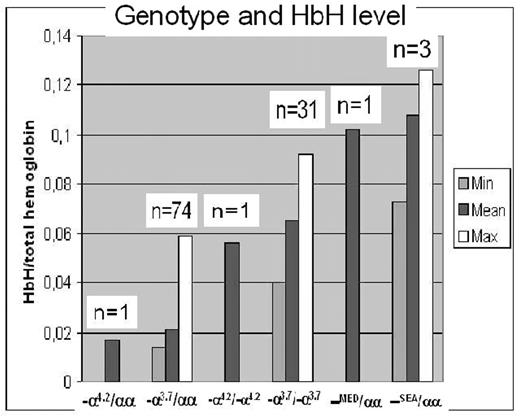Abstract
Introduction: Increasing multiethnicity is likely to make α-thalassemia minor more prevalent in Western metropolitan areas. It also increases the probability of finding newborns with Hemoglobin H disease or hydrops foetalis. Therefore, there is a need to implement screening methods to detect α-thalassemia at birth. Screening should also identify patients and families with specific requirements in genetic counselling. The goal of the present study is to evaluate the value of HbH measurement in cord blood to identify patients with α-globin deletions and patients with genotypes at risk that should be directed towards genetic counselling.
Methods: A universal neonatal screening for hemoglobinopathies and thalassemia has been performed at our institution since 2002. Between October 2002 and July 2005, hemoglobin HPLC (High Performance Liquid Chromatography, Bio-Rad Variant II)) analysis performed on ombilical cord blood identified 123 newborns with hemoglobin H (HbH). Subsequently, DNA samples were analysed by m-PCR to detect the most common alpha-globin gene deletions:-α 3.7, -α 4.2, -α 20.5, -- SEA,-- FIL, -- THAI, -- MED. Groups were formed based on the genotype (1 deletion, 2 deletions, 2 deletions in cis, 2 deletions in trans) The mean level of HbH was calculated for each genotype and group. Student t-test was used to compare the level of HbH between the different groups. Due to the heterogeneity of the group populations, a Mann-Whitney test was also used to corroborate results obtained with t-test.
Results: At least one α-globin gene deletion was observed in 90.2% of cases.(95%I.C: 83.5%-95.0%). Comparison between the groups based on the number of α-globin gene deletion and their allelic distribution allowed identification of significant differences in the HbH levels. Results were similar with Mann-Whitney (data not shown).Comparisons are presented in Table 1. HbH levels for the specific genotypes are presented in Figure 1.
Conclusion: Hemoglobin HPLC analysis performed on umbilical cord blood allows rapid and efficient detection of HbH and highly predicts the presence of common α-globin gene deletions. Moreover a significant correlation is demonstrated between the levels of HbH and the presence of an α-thalassemic genotype. HbH level seems to correlate positively with the clinical severity of the genotype. However, a discriminate level of HbH could not be established to identify patients specifically requiring genotyping and genetic counselling. Further testing is necessary to evaluate the causes of HbH expression when there is no α-globin gene deletion.
Genotype and HbH level
Mean HbH level (% of total hemoglobin)
| deletions/allelic distribution . | HbH level (means) . | HbH level (range) . | level of significance . |
|---|---|---|---|
| 1 deletion | 2.10 | 1.4–5.9 | |
| 2 deletions | 6.96 | 4.0–12.6 | p<0.001 |
| 1 deletion | 2.10 | 1.4–5.9 | |
| 2 deletions trans | 6.50 | 4.0–9.2 | p<0.001 |
| 1 deletion | 2.10 | 1.4–5.9 | |
| 2 deletions cis | 10.6 | 7.3–12.6 | p<0.01 |
| 2 deletions trans | 6.50 | 4.0–9.2 | |
| 2 deletions cis | 10.6 | 7.3–12.6 | p<0.001 |
| deletions/allelic distribution . | HbH level (means) . | HbH level (range) . | level of significance . |
|---|---|---|---|
| 1 deletion | 2.10 | 1.4–5.9 | |
| 2 deletions | 6.96 | 4.0–12.6 | p<0.001 |
| 1 deletion | 2.10 | 1.4–5.9 | |
| 2 deletions trans | 6.50 | 4.0–9.2 | p<0.001 |
| 1 deletion | 2.10 | 1.4–5.9 | |
| 2 deletions cis | 10.6 | 7.3–12.6 | p<0.01 |
| 2 deletions trans | 6.50 | 4.0–9.2 | |
| 2 deletions cis | 10.6 | 7.3–12.6 | p<0.001 |
Author notes
Corresponding author


This feature is available to Subscribers Only
Sign In or Create an Account Close Modal